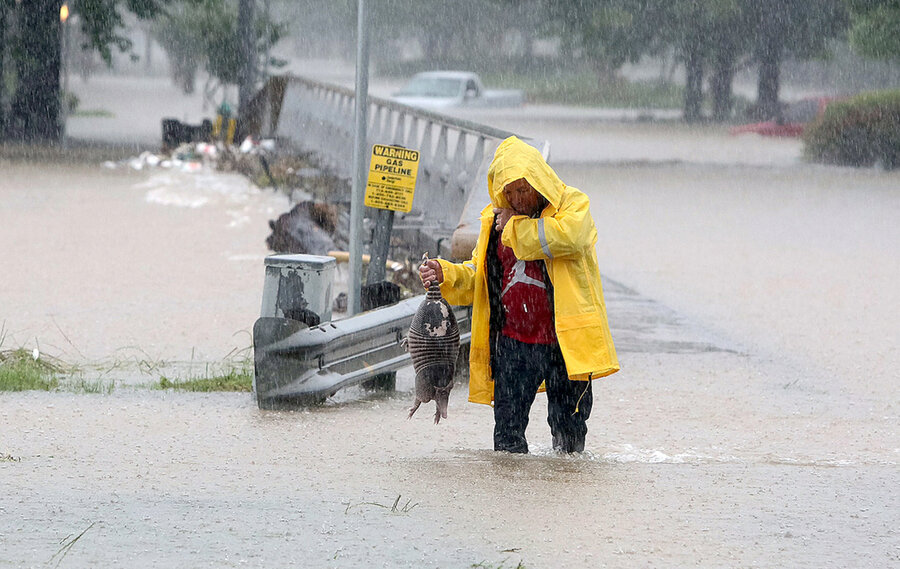As Houston floods continue, residents question the city's preparadness
Loading...
Flood control has long been a challenging issue in Houston, dating back to the city's infancy on the banks of the Buffalo Bayou when its first flood was recorded more than 170 years ago.
Major reservoirs built in the 1940s helped alleviate some of problems, but a population explosion and urban sprawl since then enveloped the reservoirs. Experts said the city's efforts since then have fallen woefully short of the massive needs. And there is climate change, which has increased the frequency of large rainfalls that threaten coastal cities, climatologists said. The result this week was that sudden downpours overwhelmed infrastructure and inundated whole sections of the city, leaving at least seven people dead.
"To throw up your hands and say we're going to be vulnerable and have hundreds of millions of dollars of impact every year in Houston just because it rains a lot is not the attitude we need to take," said Sam Brody, a professor of regional planning at Texas A&M University at Galveston. "We are not thinking about the big picture."
Thousands of people were routed from their homes and major highways when Houston's spaghetti-like web of bayous spilled over banks after rains that began Sunday night.
Then on Tuesday, creeks getting runoff from nearly 18 inches of rain in some spots in outlying northwestern Harris County rose quickly over their banks, prompting a new round of evacuations, including rescues of some residents in wheelchairs from an assisted living facility.
Prospects brightened for some as many roads reopened, although a flash flood watch was in effect through Wednesday.
"It's going to have to trickle its way through the city of Houston and to Galveston Bay," Francisco Sanchez, a county emergency services spokesman, said of the waters progressing downstream toward the Gulf of Mexico.
Houston, with more than 2 million people including 90,000 arriving last year alone, is the nation's fourth-largest city. And Harris County, which includes most of Houston, has seen a 30 percent jump in population since 2000, with an accompanying 25 percent increase in pavement.
The situation is exacerbated by a flat topography barely above sea level and the humid Gulf Coast climate prone to produce extreme rainfall.
These conditions have plagued Houston from the start, with its first flood recorded in 1843, seven years after the city was founded. There have been at least three dozen significant floods since then, including one in 1929 and another in 1935 that prompted construction of reservoirs in the western part of the county, Barker and Addicks, in the 1940s by the U.S. Army Corps of Engineers.
"They were way out in the country," said Wayne Klotz, a former American Society of Civil Engineers president who has a Houston engineering firm. "They were going to solve all the problems. The city continued to grow. And Barker and Addicks now are like in the middle of town."
Few notable flood-control efforts have been implemented since then, said Philip Bedient, a Rice University engineering professor who has been studying flood control in the area for more than three decades.
Houston's leaders "sort of forgot about it for the next 20 years, and it was the wild west," he said. "They built and built like there was no tomorrow."
"It didn't have to be this way," he said.
Among Houston's recent efforts is a voter-approved program aimed at rebuilding its streets and drainage systems to better cope with floods. The city says it has collected and spent more than $1 billion since 2012, improving 900 miles of roadway.
Brody says more could be done, including an effort to buy out homeowners flood-prone areas and turn the land into open space. He also suggests upgrading building codes to mandate elevating structures in flood-prone areas, as some suburbs have done.
"You need to think," he said. "And we're not."
The Harris County Flood Control District, the agency working in recent years with the Corps of Engineers on hundreds of millions of dollars in projects to ease the flooding impact, did not immediately return a phone message Tuesday seeking comment.
Tropical Storm Allison, with nearly 39 inches of rain in the hardest hit area, left $5 billion in damage in 2001. Hurricane Ike hit in in 2008. Just last Memorial Day, hundreds of homes along Brays Bayou in Houston sustained severe damage after an 11-inch rainstorm.
From 1999 to 2009, the Houston area incurred over $3 billion in insured flood losses, Brody said.
Money is a considerable obstacle to improved flood control.
"We know what it would take to eliminate flooding," Klotz said. "The cost is in the billions. ... We live in times of constraint of public resources. Elected bodies have elected to choose to spend on different priorities."







